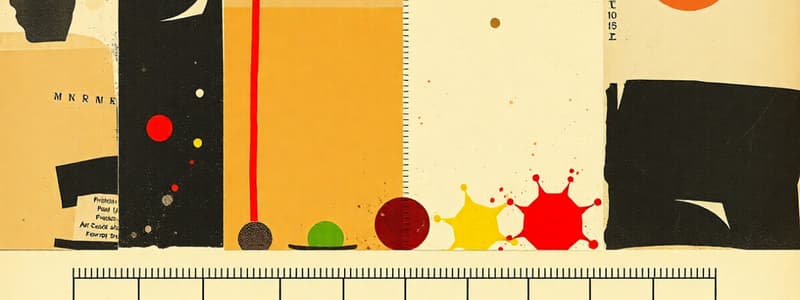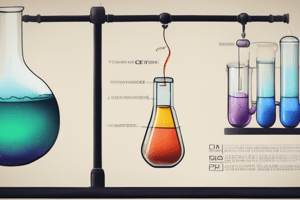Podcast
Questions and Answers
A scientist tests an unknown solution and finds that a universal indicator turns blue. Based on this observation, which of the following pH values is most likely for the solution?
A scientist tests an unknown solution and finds that a universal indicator turns blue. Based on this observation, which of the following pH values is most likely for the solution?
- 10 (correct)
- 6
- 3
- 7
Which of the following statements accurately describes the relationship between pH values and the acidity or basicity of a solution?
Which of the following statements accurately describes the relationship between pH values and the acidity or basicity of a solution?
- Solutions with a pH equal to 7 are neutral. (correct)
- Solutions with a pH greater than 7 are acidic.
- Solutions with a pH less than 7 are basic.
- Solutions with a pH of 14 are neutral.
A student is testing household substances with a universal indicator. They observe that substance X turns the indicator yellow, while substance Y turns it green. Based on these observations, what can be concluded about the relative acidity/basicity of X and Y?
A student is testing household substances with a universal indicator. They observe that substance X turns the indicator yellow, while substance Y turns it green. Based on these observations, what can be concluded about the relative acidity/basicity of X and Y?
- Substance X and Y have the same pH.
- Substance X is more basic than substance Y.
- Substance X is neutral, and substance Y is basic.
- Substance X is more acidic than substance Y. (correct)
If a solution has a pH of 2, what would be the most appropriate classification for this solution?
If a solution has a pH of 2, what would be the most appropriate classification for this solution?
Consider two solutions: Solution A has a pH of 4, and Solution B has a pH of 10. Which of the following statements correctly compares their properties?
Consider two solutions: Solution A has a pH of 4, and Solution B has a pH of 10. Which of the following statements correctly compares their properties?
If a solution has a pH of 3, which color would you expect a universal indicator to display, and what does this indicate about the solution?
If a solution has a pH of 3, which color would you expect a universal indicator to display, and what does this indicate about the solution?
Which of the following statements correctly describes the relationship between pH value and the strength of an acid or base?
Which of the following statements correctly describes the relationship between pH value and the strength of an acid or base?
Suppose a solution turns a universal indicator blue. What can be inferred about the solution based on this observation?
Suppose a solution turns a universal indicator blue. What can be inferred about the solution based on this observation?
Which of the following pairs correctly matches a substance with its expected pH range?
Which of the following pairs correctly matches a substance with its expected pH range?
A chemist tests an unknown solution with a universal indicator and observes a green color. What can the chemist most reliably conclude about the unknown solution?
A chemist tests an unknown solution with a universal indicator and observes a green color. What can the chemist most reliably conclude about the unknown solution?
Flashcards
What is pH?
What is pH?
A scale to specify the acidity or basicity of an aqueous solution.
What indicates an acidic environment?
What indicates an acidic environment?
pH values from 0 to 6.
What indicates a basic environment?
What indicates a basic environment?
pH values from 8 to 14.
What pH indicates a neutral environment?
What pH indicates a neutral environment?
Signup and view all the flashcards
What are universal indicators?
What are universal indicators?
Signup and view all the flashcards
What is an Acid?
What is an Acid?
Signup and view all the flashcards
What is a Base?
What is a Base?
Signup and view all the flashcards
What is a Universal Indicator?
What is a Universal Indicator?
Signup and view all the flashcards
What is the pH Scale?
What is the pH Scale?
Signup and view all the flashcards
What is a Neutral pH?
What is a Neutral pH?
Signup and view all the flashcards
Study Notes
The Hydrogen Index (pH)
- Litmus can differentiate whether an environment is acidic or basic.
- A universal indicator is used to determine how acidic or basic an aqueous solution is.
- This indicator changes color based on the degree of acidity or basicity of the environment.
- Not all acids have the same acidic properties and the same is true for bases. Some bases and acids are weak, while others are strong.
- Acids and bases can be ranked according to their strength, either increasing or decreasing.
- The strength of acids or bases is determined by the pH value, otherwise known as the hydrogen index and takes values from 0-14.
- The color of the universal indicator shows the pH in a substance.
Types of Substances
- Strong acid: HCl (hydrochloric acid) turns red
- Weak acid: H2CO3 (carbonic acid) turns green to yellow
- Neutral: H2O (water) turns green
- Weak base: NH4OH (ammonium hydroxide) turns blue
- Strong base: NaOH (sodium hydroxide) turns violet
- pH values from 0-6 indicate an acidic environment.
- pH values from 8-14 indicate a basic environment.
- A pH value of 7 indicates a neutral environment.
Activity
- Prepare aqueous solutions of different substances (acids, bases, salts). Use the universal indicator for each solution, noting any color change. Record the colors given by the universal indicator in each solution. Compare these with the colors on the pH scale to determine the pH value. Rank the solutions tested according to their properties: weak acid, strong acid, neutral, strong base, or weak base.
Activity Results
- Lemon juice has a universal indicator color of yellow, a pH value of 4 and a weak acid reaction to the environment
- NaOH solution has a universal indicator color of blue, a pH value of 8 and a weak base reaction to the environment
- Soap solution has a universal indicator color of green, a pH value of 8 and a weak base reaction to the environment
- Coca-cola has a universal indicator color of yellow, a pH value of 4 and a weak acid reaction to the environment
Summary
- The pH value indicates how acidic or basic an aqueous solution of a substance is.
- The universal indicator changes color each time the pH value of a solution changes.
- For pH values less than 7, the environment is acidic.
- For pH values greater than 7, the environment is basic.
- If the pH value is 7, the environment is neutral.
Studying That Suits You
Use AI to generate personalized quizzes and flashcards to suit your learning preferences.
Description
Explore the pH scale and how it measures the strength of acids and bases. Learn how universal indicators change color to reflect pH levels. Discover examples of strong and weak acids and bases, and their corresponding pH values.



